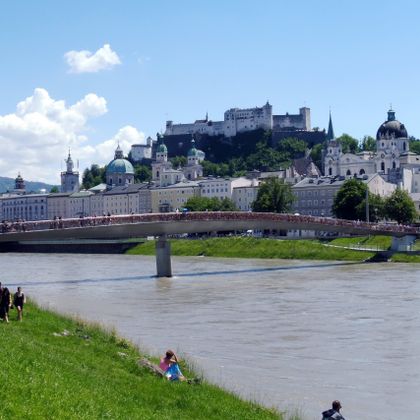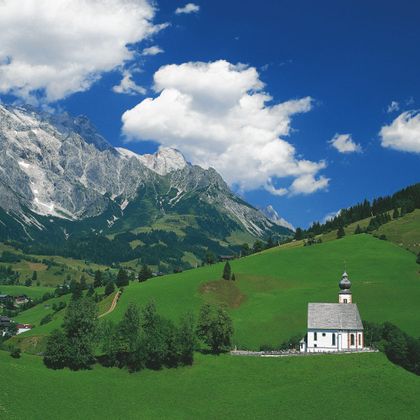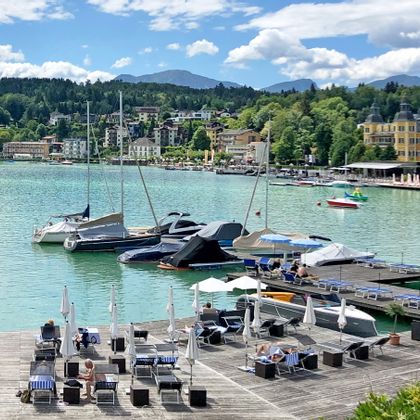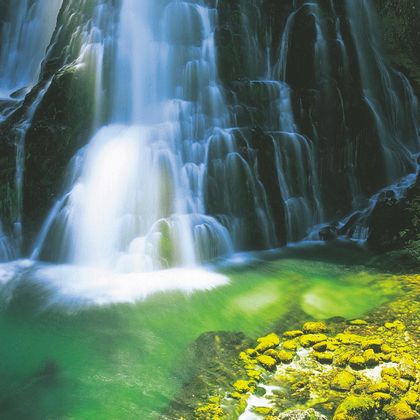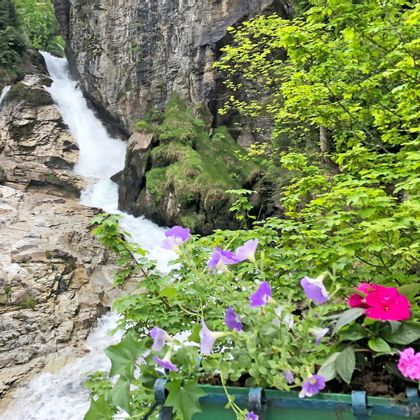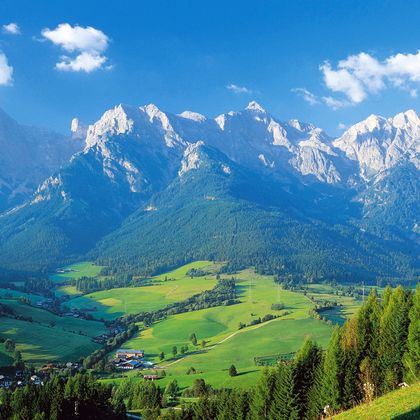Tour
Arrive early, because it is worth it! There is a lot to discover in Salzburg with the Hohensalzburg Fortress, Mirabell Palace and Mozart's birthplace in the old town, which is well worth seeing. Dreamy cafés with genuine Austrian coffee specialties will put you in the right mood for this trip.
Through shady meadows along the Salzach River, you will enjoy cycling south from Salzburg to Hallein. Take a break here in the medieval heart of the city. Stroll through the narrow streets and across the wide squares of the historic salt and Celtic town. Hallein will surprise you with a romantic old town, historic archways and houses with magnificent facades. Passing the gushing waterfall, you will then roll on to Golling with its pretty market square and 13th century castle.
Today you cycle on the well-built Salzach cycle path more or less always directly along the river bank to St. Johann. Unmistakably - like double mountain peaks - the towers of the Pongau Cathedral rise up from afar. Look forward to the little town and enjoy the special atmosphere of this little shopping paradise. Whether modern or traditional, friendly stores invite you to browse, cozy inns and inviting restaurants promise a nice evening.
Another 7 kilometers of cycling along the Salzach River to Schwarzach. From here the Gasteiner Ache accompanies you through the wild and romantic Gasteiner Valley. Via Dorfgastein and Bad Hofgastein you will enjoy cycling through the Hohe Tauern National Park to the famous spa and winter sports resort of Bad Gastein. Marvel here at the impressive Belle Époque-era villas built on the steep slopes. Surrounded by peaks that top the three-thousand-meter mark, Bad Gastein is the Monte Carlo of the Alps! Take a worthwhile break here and marvel at the narrow center that has grown up around the waterfall. Then cycle another 4 km to the train station in Böckstein. You will use the train, which will take you comfortably to the other side of the Alps to Mallnitz in just 10 minutes. Look forward to your bike ride into the Mölltal, as a rushing downhill will bring you along briskly.
Enjoy the Mölltal, which got its name from the small river Möll. The Möll rises at the Großglockner and flows into the Drava only 80 km later. Let yourself be fascinated by the white water of the Möll and the impressive high mountain landscape. Look forward to the Drau Valley, because this is where the sunny south of Austria begins. Almost by itself your bike will roll downhill along the Drau river. Visit Porcia Castle in Spittal, as it is one of the most important Renaissance buildings in Austria!
Most of the time you will roll along the banks of the Drava River from one small highlight to the next. Excavations of an early Christian church near Molzbichl, an archaeological museum and the Dobratsch Nature Park near Villach await you. Stroll through Villach in the afternoon and discover the old alleys and idyllic arcaded courtyards. Enjoy the vibrant life of the more than 800-year-old trading town and visit the late Gothic city parish church, one of the most beautiful hall churches in the country.
You can bridge the climb to Tarvisio by train. The cycle path is also well developed in Italy, so you can cycle comfortably downhill through the Canal Valley and admire the beauty of the Friulian Alpine region with its unspoiled nature and extensive forests from the saddle. You will spend the night in one of the pretty villages at the foothills of the Julian Alps. Marvel at the beautiful façade of the Cathedral of Santa Maria Assunta in Gemona and stroll through the narrow streets of the old town. In 1976, Friuli was hit by a severe earthquake (6.5 on the Richter scale), whose epicenter was near Gemona. Gemona and the neighboring communities of Venzone and Osoppo were severely damaged. The right aisle and the campanile of the famous Cathedral of Santa Maria Assunta (Assumption of Mary) collapsed. Everything has now been rebuilt as well as possible, including the campanile (bell tower), but the columns in the cathedral are still slightly crooked.
Shortly after Gemona, turn off towards Udine. You will then cycle criss-cross through fields and meadows from one village to the next. Look forward to Udine, a small town with flair, where you can feel the “dolce vita.” Marvel at the Piazza della Liberta, one of the most beautiful squares in northern Italy, with its Palladian gate and Venetian clock tower, and don't miss out on an espresso or cappuccino here. Stroll through the historic center and marvel at the cathedral and the castle on the hill above the town.
Today you cycle through wide reed landscapes and along small water channels towards the Gulf of Venice. On your bike route to the Adriatic coast you should definitely stop in Aquileia. The historic Roman city has been a UNESCO World Heritage Site since 1998. Remains of the Roman city have been uncovered in parts such as the forum and the inland port. In Aquileia, also visit the medieval basilica from the 11th century, which is famous for its early Christian floor mosaics. The mosaics are among the most important in the country! Now it's only about 10 km to Grado. Look forward to one of the most popular seaside resorts on the Adriatic with an extensive sandy beach and a historic fishing town. End the evening and your trip in the narrow streets with cozy restaurants and Italian flair.
After breakfast your varied cycling tour comes to an end. We will gladly book additional nights in Grado for you. If you want to go back to Salzburg, you have the possibility to book our return transfer.
Map
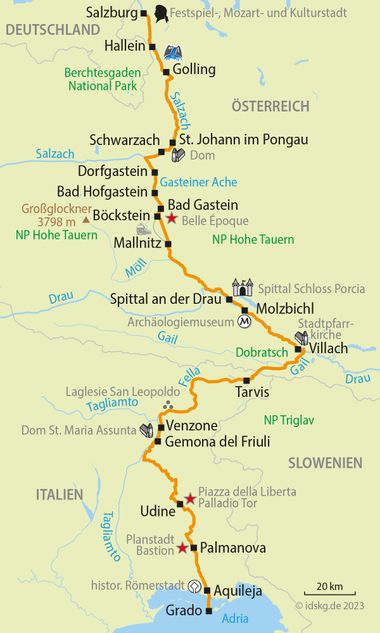
Prices / Dates
Services / Info
- Accommodation incl. breakfast in 3- and 4-star hotels
- Room with shower/bath/WC
- Luggage transport
- Personal tour information
- 1 train ride Böckstein - Mallnitz incl. bike
- 1 train ride Villach - Tarvis incl. bike
- Digital route guidance via smartphone app
- Tips for tour preparation
- Touristic information
- 7 days hotline service
Below you will find specific information about the individual bike tour Salzburg - Grado. If you have any further questions about this trip, just give us a call: Phone: +49 (0)6421 - 886890.
Arrival by car
In Austria there are tolls and freeway fees. Vignettes are compulsory on the freeways in Austria. Vignettes can be purchased at German gas stations just before the border or at the border.
Arrival by train
The best way to get to our partner hotels in Salzburg from the Salzburg main station is a short taxi ride. Current timetable and price information can be found at: Train schedule information Deutsche Bahn and Train schedule information ÖBB
Parking facilities at the starting hotel
Some of the arrival hotels have parking spaces that cannot be reserved in advance. Costs approx. € 12.00 - 15.00 per day. Public car parks are a good alternative to hotel parking spaces. The costs are approx. € 80.00 - 115.00 per week. You will receive detailed information on parking at the hotel booked for you with the detailed travel documents two weeks before the start of your journey.
Condition of the cycle paths
You will cycle mainly on well-maintained cycle paths and quiet side roads. Only a few sections are on roads with heavier traffic or unpaved paths. Overall, the route is gently hilly, whereby the most demanding section between St. Johann and the Gastein Valley can be bridged by train.
Tour information and bike handover
The personal tour information with subsequent bike handover takes place on the day of arrival. The exact time will be announced by the reception upon arrival. If you do not wish to participate in the tour information, documents and rental bikes will be left at the arrival hotel. A short message in advance is very welcome!
Available rental bikes
For this trip, you can choose between 21/24-speed unisex bikes with derailleur gears in various frame heights and 8-speed electric bikes. Simply let us know your bike preference when booking.
Return transfer to the starting point of the trip
An organized return transfer can be booked in advance from Grado to Salzburg. The return transfer takes place every Thursday, Friday, Saturday and Sunday starting in the morning with the shuttle bus incl. bike. Advance booking is required. Travel time about 5.5 h, depending on traffic. Alternatively, a return journey by train from Grado to Salzburg is only possible with several changes.
Cycling in Austria and Italy
In Austria there is no helmet obligation, but wearing a helmet is highly recommended. Since 2011, cyclists in Italy are required to wear high-visibility vests outside built-up areas at night (half an hour before sunset to half an hour before sunrise). In addition, high visibility vests are compulsory when cycling in tunnels with road traffic.
Weather/ Climate
The climate in Austria can be classified as the humid-warm temperate zone. The ideal time for cycling is therefore spring, summer and autumn. Upper Italy is still in the Central European climate zone (cold winters). From the Po Valley on, the temperate-subtropical transitional climate begins. The center and the south of the country are characterized by mild-humid winters and dry-hot summers. During the summer months it is advisable to pack light, easily washable clothes, and for the evenings light woolen clothes should not be missing in the luggage. For the rest of the year it is recommended to bring transitional clothes and warmer woolen clothes.
Extra costs, which are not included in the travel price
Any tourist tax and charging fees for bicycle batteries are not included in the tour price and must therefore be paid at the hotel.
7 days hotline service
If the bicycle chain is broken, floods make the further journey impossible or other bad surprises are waiting for you: We are available 7 days a week for you and organize help as quickly as possible.
Passport and visa requirements
For EU citizens, there are no special passport or visa requirements and no health formalities to be considered for this trip.
Travel insurance
The tour price already includes the statutory insolvency insurance. In addition, we recommend that you take out travel cancellation insurance upon receipt of your travel confirmation in order to protect yourself against financial disadvantages in the event of travel cancellation, interruption of travel, illness or accident.
For this trip, we recommend using digital travel documents in the interest of sustainability. However, if you prefer, you can choose printed travel documents with a cycling map during the booking process.
Please note that price differences may apply depending on your selection.

I provide you with advice and assistance
Frank Geißler
